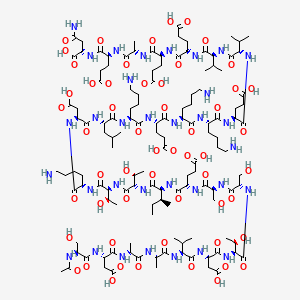



1. Alpha1 Thymosin
2. Alpha1-thymosin
3. Thymosin Alpha(1)
4. Thymosin Alpha1
5. Zadaxin
1. 62304-98-7
2. Zadaxin
3. Thymosin Alpha 1
4. Thymosin Alpha1
5. Thymosin-alpha-1
6. 69440-99-9
7. N-acetyl-l-seryl-l-alpha-aspartyl-l-alanyl-l-alanyl-l-valyl-l-alpha-aspartyl-l-threonyl-l-seryl-l-seryl-l-alpha-glutamyl-l-isoleucyl-l-threonyl-l-threonyl-l-lysyl-l-alpha-aspartyl-l-leucyl-l-lysyl-l-alpha-glutamyl-l-lysyl-l-lysyl-l-alpha-glutamyl-l-valyl-l-valyl-l-alpha-glutamyl-l-alpha-glutamyl-l-alanyl-l-alpha-glutamyl-l-asparagine
8. 69521-94-4
9. Thymosin Alpha1 (ox)
10. Thymosin Alpha1 (human)
11. Alpha1-thymosin
12. Thymalfasin [usan:inn]
13. Thymosin Alpha(1)
14. Thymosin Alpha1 Acetate
15. Thymosin Alpha1 (cattle)
16. Unii-w0b22isq1c
17. Thymlfasin
18. Thymosin
19. A1
20. Thymosin .alpha.1
21. Thymosins Thymalfasin
22. Thymosin A1 (cattle)
23. Thymosin A1thymosin A1
24. Thymosin I+/-1 Bovine
25. Alpha1-thymosinthymalfasin
26. W0b22isq1c
27. .alpha.1-thymosinthymalfasin
28. Thymosin .alpha.1 (cattle)
29. Ccris 7707
30. Emz702
31. Chembl2103979
32. Schembl15531955
33. Dtxsid80211374
34. Chebi:135915
35. Thymosin-alpha-1 & .alpha. Ifn
36. Akos015994639
37. Hs-2030
38. L-asparagine, N-acetyl-l-seryl-l-alpha-aspartyl-l-alanyl-l-alanyl-l-valyl-l-alpha-asparatyl-l-threonyl-l-seryl-l-seryl-l-alpha-glutamyl-l-isoleucyl-l-threonyl-l-threonyl-l-lysyl-l-alpha-aspartyl-l-leucyl-l-lysyl-l-alpha-glutamyl-l-lysyl-l-lysyl-l-alpha-glutamyl-l-valyl-l-valyl-l-alpha-glutamyl-l-alpha-glutamyl-l-alanyl-l-alpha-glutamyl-
39. Thymosin Alpha1 Bovine, >=90% (hplc)
40. Ac-sdaavdtsseittkdlkekkevveeaen-cooh
41. 304t987
42. Ac-ser-asp-ala-ala-val-asp-thr-ser-ser-glu-ile-thr-thr-lys-asp-leu-lys-glu-lys-lys-glu-val-val-glu-glu-ala-glu-asn-oh
| Molecular Weight | 3108.3 g/mol |
|---|---|
| Molecular Formula | C129H215N33O55 |
| XLogP3 | -24 |
| Hydrogen Bond Donor Count | 49 |
| Hydrogen Bond Acceptor Count | 59 |
| Rotatable Bond Count | 111 |
| Exact Mass | 3107.5074829 g/mol |
| Monoisotopic Mass | 3106.5041281 g/mol |
| Topological Polar Surface Area | 1460 Ų |
| Heavy Atom Count | 217 |
| Formal Charge | 0 |
| Complexity | 7190 |
| Isotope Atom Count | 0 |
| Defined Atom Stereocenter Count | 32 |
| Undefined Atom Stereocenter Count | 0 |
| Defined Bond Stereocenter Count | 0 |
| Undefined Bond Stereocenter Count | 0 |
| Covalently Bonded Unit Count | 1 |
Indicated as an adjuvant for influenza vaccine in elderly patients and as an adjuvant for both influenza and hepatitis B vaccines in chronic hemodialysis patients who failed to achieve adequate antibody titers from previous immunization.
Investigated for use/treatment in hepatitis (viral, C).
Thymalfasin is a 28-amino acid polypeptide produced synthetically but originally isolated from thymosin fraction 5, a bovine thymus extract containing a number of immunologically active peptides. In vitro studies have shown that Thymalfasin can influence T-cell production and maturation, stimulate production of Th1 cytokines such as interferon-gamma and interleukin-2, and activate natural killer cell-mediated cytotoxicity.
Adjuvants, Immunologic
Substances that augment, stimulate, activate, potentiate, or modulate the immune response at either the cellular or humoral level. The classical agents (Freund's adjuvant, BCG, Corynebacterium parvum, et al.) contain bacterial antigens. Some are endogenous (e.g., histamine, interferon, transfer factor, tuftsin, interleukin-1). Their mode of action is either non-specific, resulting in increased immune responsiveness to a wide variety of antigens, or antigen-specific, i.e., affecting a restricted type of immune response to a narrow group of antigens. The therapeutic efficacy of many biological response modifiers is related to their antigen-specific immunoadjuvanticity. (See all compounds classified as Adjuvants, Immunologic.)
Absorption
Rapidly absorbed with peak serum levels achieved at approximately 2 hours.
Approximately 2 hours. There is no evidence of accumulation following multiple subcutaneous doses.
The mechanism of action of thymalfasin is not completely understood but is thought to be related to its immunomodulating activities, centered primarily around augmentation of T-cell function. In various in vitro assays, thymosin alpha 1 has been shown to promote T-cell differentiation and maturation; for example, CD4+, CD8+, and CD3+ cells have all been shown to be increased. Thymosin alpha 1 has also been shown to increase production of IFN-g, IL-2, IL-3, and expression of IL-2 receptor following activation by mitogens or antigens, increase NK cell activity, increase production of migratory inhibitory factor (MIF), and increase antibody response to T-cell dependent antigens. Thymosin alpha 1 has also been shown to antagonize dexamethasone-induced apoptosis of thymocytes in vitro. In vivo administration of thymosin alpha 1 to animals immunosuppressed by chemotherapy, tumor burden, or irradiation showed that thymosin alpha 1 protects against cytotoxic damage to bone marrow, tumor progression and opportunistic infections, thereby increasing survival time and number of survivors. Many of the in vitro and in vivo effects of thymosin alpha 1 have been interpreted as influences on either differentiation of pluripotent stem cells to thymocytes or activation of thymocytes into activated T-cells. Thymalfasin also has been shown in vitro to upregulate expression of toll like receptors (TLR) including TLR2 and TLR9 in mouse and human dendritic cells, as well as activate NF-kB and JNK/P38/AP1 pathways. Thymalfasin's activation of dendritic cells provides another possible pathway explaining thymalfasin's immunomodulatory and antiviral effects.
